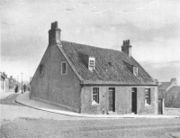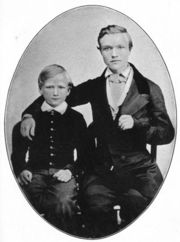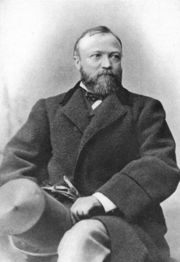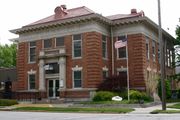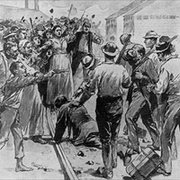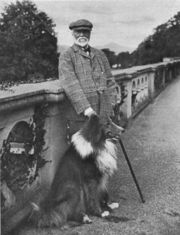Andrew Carnegie
2007 Schools Wikipedia Selection. Related subjects: Engineers and inventors
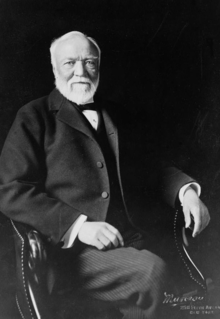 |
|
| Born: | November 25, 1835 Dunfermline, Scotland |
|---|---|
| Died: | August 11, 1919 Lenox, Massachusetts |
| Occupation: | Businessman and Philanthropist |
Andrew Carnegie ( November 25, 1835 – August 11, 1919) was a Scottish-American businessman, a major philanthropist, and the founder of the Carnegie Steel Company which later became U.S. Steel. He is known for having built one of the most powerful and influential corporations in United States history, and, later in his life, giving away most of his riches to fund the establishment of many libraries, schools, and universities in Scotland, America and worldwide.
Early life
Scotland
Andrew Carnegie was born on November 25, 1835, in Dunfermline, Fife, Scotland. He was the son of a hand loom weaver, William Carnegie. His mother, Margaret, was a daughter of Thomas Morrison, a tanner and shoemaker. Although his family was impoverished, he grew up in a cultured, political home.
Many of Carnegie's closest relatives were self-educated tradesmen and class activists. William Carnegie, although poor, had educated himself and, as far as his resources would permit, ensured that his children received an education. William Carnegie was politically active and was involved with those organising demonstrations against the Corn laws. He was also a Chartist. He wrote frequently to newspapers and contributed articles in the radical pamphlet, Cobbett's Register edited by William Cobbett. Amongst other things, he argued for abolition of the Rotten Boroughs and reform of the British House of Commons, Catholic Emancipation, and laws governing safety at work, which were passed many years later in the Factory Acts. He promoted the abolition of all forms of hereditary privilege, including all monarchies.
Another great influence on the young Andrew Carnegie was his uncle, George Lauder, a proprietor of a small grocer's shop in Dunfermline High Street. This uncle introduced the young Carnegie to such historical Scottish heroes as Robert the Bruce, William Wallace, and Rob Roy. He was introduced to the writings of Robert Burns and Shakespeare. Lauder had Carnegie commit to memory many pages of Burns's writings.
George Lauder was interested in the United States. Lauder saw the U.S. as a country with "democratic institutions". Carnegie later considered the U.S. as the role model for democratic government.
Another uncle, his mother's brother, Tom Kennedy, was also a radical political firebrand. A fervent nonconformist, the chief objects of his tirades were the Church of England and the Church of Scotland. In 1842, the young Carnegie's radical sentiments were stirred further at the news of "Ballie" being imprisoned for his part in a "Cessation of Labour" ( strike). At the time, withdrawal of labour by a hireling was a criminal offense.
Andrew Carnegie's direct descendants still live in Scotland today. William Thomson CBE, the great grandson of Andrew, is Chairman of the Carnegie Trust Dunfermline, a trust which maintains Andrew Carnegie's legacy.
Immigration to America
Andrew Carnegie's weaver work involved receiving the mill's raw materials at his cottage and weaving them into cloth on the primitive loom in the cottage. In the 1840s, a new system was coming into being, the factory system. During this era, mill owners began constructing weaving mills with looms powered at first by water wheels and later by steam engines. These factories could produce cloth at far lower cost, partly through increased mechanisation and economies of scale, but partly also by paying mill workers very low wages and by working them very long hours. The success of the mills forced hundreds of hand loom workers to find work elsewhere, including Andrew's father William.
He chose to emigrate. His mother had two sisters who had already emigrated, but it was his wife who persuaded William Carnegie to make the passage. Making the passage was not easy, however, for they had to find the passage money. They were forced to sell their meagre possessions and borrow some £20 from friends, a considerable sum in 1848.
In May 1848, his family emigrated to the United States, sailing on the Wiscasset, a former whaler that took the family from Broomielaw in Glasgow to New York City. From there they proceeded up the Hudson River and the Erie Canal to Lake Erie and then to Allegheny, Pennsylvania (present day Pittsburgh's northside neighborhoods), where William Carnegie found work in a cotton factory.
Young Andrew Carnegie found work in the same building as a "Bobbin boy" for the sum of US$1.20 a week. His brother, Thomas, eight years younger, was sent to school. Andrew Carnegie quickly grew accustomed to his new country: three years after arriving in the United States, the young Carnegie began writing to his friends in Scotland extolling the great virtues of American democracy whilst disparaging and criticising "feudal British institutions". At the same time, he followed in his father's footsteps and wrote letters to the newspapers including the New York Tribune on subjects such as slavery.
Early career
1850–1860: A 'self made man'
Andrew Carnegie's education and passion for reading was given a great boost by Colonel James Anderson, who opened his personal library of 400 volumes to working boys each Saturday night. Carnegie was a consistent borrower. He was a "self-made man" in both his economic development and his intellectual and cultural development. His capacity and willingness for hard work, his perseverance, and his alertness, soon brought forth opportunities.
In 1851, he became a telegraph messenger boy in the Pittsburgh Office of the Ohio Telegraph Company, at US$2.50 per week. This, to the young Carnegie, seemed like a fortune. In addition to providing him with an increase in income, the job also provided him with a lifelong love of William Shakespeare's works. He was frequently required to deliver messages to a theatre, and he often managed to contrive appearing just as the curtain had been raised on a performance. Using a charm that was to pay even greater dividends in the future, Carnegie was then usually able to convince the theatre's manager to allow him to stay and watch the performance for free. When Carnegie was not at the theatre or improving his mind with a book, he would spend time listening to the telegraph instrument itself. The electric telegraph transmitted its signals along the wires that traversed the nation. When they were received into the telegraph office, they were transcribed into readable script on a long paper tape with the aid of an elaborate machine. He quickly learned to distinguish the differing sound the incoming signals produced and learned to transcribe it by ear without having to write it down. At the time, Andrew Carnegie was one of only two or three persons so gifted in the entire country. Having learned telegraphy, he was noted by Thomas A. Scott of the Pennsylvania Railroad Company, who employed him as a secretary/telegraph operator starting in 1853, at a salary of US$4.00 per week. Carnegie was eighteen and soon began a rapid advancement through the company, eventually becoming the superintendent of the Pittsburgh Division.
1860–1865: Civil War
Before the Civil War Carnegie had formed a partnership with a Mr. Woodruff, an inventor. Woodruff's invention was the sleeping car. The great distances transversed by railways had meant stopping for the night at hotels and inns by the railside, so that passengers could rest. The sleeping car sped up travel and helped Americans settle the American West. The investment proved a great success and a source of great fortune for Woodruff and Carnegie. The young Carnegie became the superintendent of the Western Division. In this post, Carnegie was responsible for several improvements in the service.
When the Civil War began in 1861, he accompanied his boss, Thomas A. Scott, to the front lines, where he was "the first casualty of the war" when he pulled up telegraph wires the Confederate Army had buried. He gained a scar on his cheek from when the wire came up too fast and cut him. He would tell the story of that scar for years to come.
Carnegie was selected by Scott, who was now Assistant Secretary of War in charge of military transportation, to join him in Washington, D.C. Carnegie was appointed Superintendent of the Military Railways and the Union Government's telegraph lines in the East. Carnegie was on the foot plate of the locomotive that pulled the first brigade of Union troops to reach Washington. Shortly after this, following the defeat of Union forces at Bull Run, he personally supervised the transportation of the defeated forces. Under his organization, the telegraph service rendered efficient service to the Union cause and significantly assisted in the eventual victory. During his work "in the field", Carnegie fell ill and needed treatment for sunstroke.
Carnegie proceeded to increase his wealth through careful investments. In 1864, Carnegie invested US$40,000 in Storey Farm on Oil Creek in Venango County, Pennsylvania. In one year, the farm yielded over US$1,000,000 in cash dividends, and petroleum from oil wells on the property sold profitably. Carnegie was subsequently associated with others in establishing a steel rolling mill.
The Civil War, as so many wars before it, brought boom times to the suppliers of war. The U.S. iron industry was one such profiter. Before the war its production was of little significance, but the sudden huge demand brought boom times to Pittsburgh and similar cities and great wealth to the iron masters.
Carnegie had some investments in this industry before the war and, after the war, he left the railroads to devote all his energies to the ironworks trade. Carnegie worked to develop several iron works, eventually forming The Keystone Bridge Works and the Union Ironworks, in Pittsburgh. Although he had left the Pennsylvania Railroad Company, he did not totally sever his links with the railroads. The Keystone Bridge Company made iron train bridges, and, as company superintendent, Carnegie had noticed the weakness of the traditional wooden structures. These were replaced in large numbers with iron bridges made in his works. As well as having good business sense, Carnegie possessed charm and literary knowledge. He was invited to many important social functions—functions that Carnegie exploited to his own advantage.
Carnegie’s philanthropic inclinations began some time before retirement. He wrote;
| I propose to take an income no greater than $50,000 per annum! Beyond this I need ever earn, make no effort to increase my fortune, but spend the surplus each year for benevolent purposes! Let us cast aside business forever, except for others. Let us settle in Oxford and I shall get a thorough education, making the acquaintance of literary men. I figure that this will take three years active work. I shall pay especial attention to speaking in public. We can settle in London and I can purchase a controlling interest in some newspaper or live review and give the general management of it attention, taking part in public matters, especially those connected with education and improvement of the poorer classes. Man must have an idol and the amassing of wealth is one of the worst species of idolatry! No idol is more debasing than the worship of money! Whatever I engage in I must push inordinately; therefore should I be careful to choose that life which will be the most elevating in its character. To continue much longer overwhelmed by business cares and with most of my thoughts wholly upon the way to make more money in the shortest time, must degrade me beyond hope of permanent recovery. I will resign business at thirty-five, but during these ensuing two years I wish to spend the afternoons in receiving instruction and in reading systematically! |
1880–1900: scholar and activist
Whilst Carnegie continued his business career, some of his literary intentions were fulfilled. During this time, he made many friends in the literary and political worlds. Among these were such as Matthew Arnold and Herbert Spencer as well as being in correspondence and acquaintance with most of the U.S. Presidents, statesmen, and notable writers of the time. Many were visitors to the Carnegie home. Carnegie greatly admired Spencer. He did not, however, agree with Spencer's Social Darwinism which held that philanthropy was a bad idea.
In 1881, Carnegie took his family, which included his mother, then age 70, on a trip to Great Britain. They toured the Scotland by coach, having several receptions en-route. The highlight for them all was a triumphal return to Dunfermline where Carnegie's mother laid the foundation stone of the "Carnegie Library". Andrew Carnegie's criticism of British society did not point to a dislike of the country of his birth; on the contrary, one of Carnegie's ambitions was to act as a catalyst for a close association between the English speaking peoples. To this end, he purchased, in the first part of the 1880s, numerous newspapers in England, all of which were to advocate the abolition of the monarchy and the establishment of "the British Republic". Carnegie's charm aided by his great wealth meant that he had many British friends, including Prime Minister Gladstone.
In 1886, Carnegie's younger brother Thomas died at age 43. Success in the business continued, however. At the same time as owning steel works, Carnegie had purchased, at low cost, the most valuable of the iron ore fields around Lake Superior. The same year Andrew Carnegie became a figure of controversy. Following his tour of Great Britain, he wrote about his experiences in a book entitled An American Four-in-hand in Britain. Although still actively involved in running his many businesses, Carnegie had become a regular contributor of articles to numerous magazines, most notably the Nineteenth Century, under the editorship of James Knowles, and the North American Review, whose editor, Lloyd Bryce, oversaw the publication during its most influential period.
In 1886, Carnegie penned his most radical work to date, entitled Triumphant Democracy. The work, liberal in its use of statistics to make its arguments, was an attempt to argue his view that the American republican system of government was superior to the British monarchical system. It gave an overly-favourable and idealistic view of American progress and had considerable criticism of the British royal family. Most antagonistic, however, was the cover that depicted amongst other motifs, an upended royal crown and a broken scepter. Given these aspects, it was no surprise that the book was the cause of considerable controversy in Great Britain. The book itself was successful. It made many Americans aware for the first time of their country's economic progress and sold over 40,000 copies, mostly in the U.S.
In 1889, Carnegie published an article entitled "Wealth" in the June issue of the North American Review. After reading it, Gladstone requested its publication in England, and it appeared under a new title, "The Gospel of Wealth" in the Pall Mall Gazette. The article was the subject of much discussion. In the article, the author argued that the life of a wealthy industrialist such as Carnegie should comprise two parts. The first part was the gathering and the accumulation of wealth. The second part was to be used for the subsequent distribution of this wealth to benevolent causes.
In 1898, Carnegie tried to give the Philippines its independence. As the end of the Spanish American War neared, the United States bought the Philippines from Spain for $20 million USD. To counter what he perceived as imperialism on the part of the United States, Carnegie personally offered $20 million USD to the Philippines so that the Filipino people could buy their independence from Spain. However, nothing came of this gesture and the Philippine-American War ensued.
Industrialist
1885–1900: Empire of Steel
Carnegie made his fortune in the steel industry, controlling the most extensive integrated iron and steel operations ever owned by an individual in the United States. His great innovation was in the cheap and efficient mass production of steel rails for railroad lines.
In the late 1880s, Carnegie Steel was the largest manufacturer of pig iron, steel rails, and coke in the world, with a capacity to produce approximately 2,000 tons of pig metal per day. In 1888, he bought the rival Homestead Steel Works, which included an extensive plant served by tributary coal and iron fields, a 425-mile (685 km) long railway, and a line of lake steamships. An agglutination of Carnegie's assets and those of his associates occurred in 1892 with the launching of the Carnegie Steel Company.
By 1889, the U.S. output of steel exceeded that of the UK, and Andrew Carnegie owned a large part of it. Carnegie's empire grew to include the J. Edgar Thomson Steel Works, (named for John Edgar Thomson, Carnegie's former boss and president of the Pennsylvania Railroad), Pittsburgh Bessemer Steel Works, the Lucy Furnaces, the Union Iron Mills, the Union Mill (Wilson, Walker & County), the Keystone Bridge Works, the Hartman Steel Works, the Frick Coke Company, and the Scotia ore mines. Carnegie, through Keystone, supplied the steel for and owned shares in the landmark Eads Bridge project across the Mississippi River in St. Louis, Missouri (completed 1874). This project was an important proof-of-concept for steel technology which marked the opening of a new steel market.
1901: U.S. Steel
In 1901, Carnegie was 65 years old and was considering retirement. He reformed his enterprises into conventional joint stock corporations as preparation to this end.
John Pierpont Morgan was a banker and perhaps America's most important financial deal maker. He had observed how efficiency produced profit. He envisioned an integrated steel industry that would cut costs, lower prices to consumers and raise wages to workers. To this end, he needed to buy out Carnegie and several other major producers and integrate them into one company, thereby eliminating duplication and waste. Negotiations were concluded on March 2, 1901, with the formation of the United States Steel Corporation. It was the first corporation in the world with a market capitalization in excess of US$1 billion.
The buyout, which was negotiated in secret by Charles M. Schwab (no relation to Charles R. Schwab, the brokerage house founder), was the largest such industrial takeover in United States history to date. The holdings were incorporated in the United States Steel Corporation, a trust organized by Morgan, and Carnegie retired from business. His steel enterprises were bought out at a figure equivalent to twelve times their annual earnings—US$480 million —which at the time was the largest ever personal commercial transaction. Andrew Carnegie's share of this amounted to US$225,639,000, which was paid to Carnegie in the form of 5%, 50 year gold bonds. The letter agreeing to sell his share was signed on February 26, 1901. On March 2, the circular formally filing the organization and capitalization (at US$1,400,000,000—4% of U.S. national wealth at the time) of the United States Steel Corporation actually completed the contract. The bonds were to be delivered within two weeks to the Hudson Trust Company of Hoboken, New Jersey, in trust to Robert A. Franks, Carnegie's business secretary. There, a special vault was built to house the physical bulk of nearly US$230,000,000 worth of bonds. It was said that "....Carnegie never wanted to see or touch these bonds that represented the fruition of his business career. It was as if he feared that if he looked upon them they might vanish like the gossamer gold of the leprechaun. Let them lie safe in a vault in New Jersey, safe from the New York tax assessors, until he was ready to dispose of them...."
As they signed the papers of sale, Carnegie remarked, "Well, Pierpont, I am now handing the burden over to you." In return, Andrew Carnegie became one of the world's wealthiest men!
Retirement
Retirement was something many men dreaded. Carnegie was not one of them. He looked forward to retirement when he could chart a new course in life.
Besides steel, Carnegie's companies were involved in other areas of the railroad industry. His company, Pittsburgh Locomotive and Car Works, was noted for its building of large steam locomotives at the turn of the 20th century. His associates and partners included Henry Clay Frick and F. T. F. Lovejoy.
At the height of his career, he was the second richest person in the world, behind only John D. Rockefeller.
1901–1915: philanthropist
Andrew Carnegie spent his last years as a philanthropist. From 1901 forward, public attention was turned from the shrewd business capacity which had enabled Carnegie to accumulate such a fortune, to the public-spirited way in which he devoted himself to utilizing it on philanthropic objects. His views on social subjects and the responsibilities which great wealth involved were already known from Triumphant Democracy (1886), and from his Gospel of Wealth (1889). He acquired Skibo Castle, in Sutherland, Scotland, and made his home partly there and partly in New York. He then devoted his life to the work of providing the capital for purposes of public interest and social and educational advancement.
He was a powerful supporter of the movement for spelling reform as a means of promoting the spread of the English language.
Among all of his many philanthropic efforts, the establishment of public libraries in the United States, the United Kingdom, and in other English-speaking countries was especially prominent. Carnegie libraries, as they were commonly called, were built seemingly everywhere. The first was opened in 1883 in Dunfermline, Scotland. His method was to build and equip, but only on condition that the local authority provided site and maintenance. To secure local interest, in 1885, he gave US$500,000 to Pittsburgh for a public library, and in 1886, he gave US$250,000 to Allegheny City for a music hall and library, and US$250,000 to Edinburgh, Scotland, for a free library. In total Carnegie funded some 3,000 libraries, located in every U.S. state except Alaska, Delaware, and Rhode Island. Carnegie also built libraries in Canada and overseas in Britain, Ireland, Australia, New Zealand, the West Indies, and Fiji.
He gave US$2 million in 1901 to start the Carnegie Institute of Technology (CIT) at Pittsburgh, and the same amount in 1902 to found the Carnegie Institution at Washington, D.C. He later contributed more to these and other schools. CIT is now part of Carnegie Mellon University.
In Scotland, he gave US$2 million in 1901 to establish a trust for providing funds for assisting education at the Scottish universities, a benefaction which resulted in his being elected Lord Rector of University of St. Andrews. He was a large benefactor of the Tuskegee Institute under Booker Washington for African American education. He also established large pension funds in 1901 for his former employees at Homestead and, in 1905, for American college professors. He also funded the construction of 7,000 church organs.
Also, long before he sold out, in 1879, he erected commodious swimming-baths for the use of the people of his hometown of Dunfermline, Scotland. In the following year, Carnegie gave US$40,000 for the establishment of a free library in the same city. In 1884, he gave US$50,000 to Bellevue Hospital Medical College to found a histological laboratory, now called the Carnegie Laboratory.
He owned Carnegie Hall in New York City.
He founded the Carnegie Hero Fund commissions in America (1904) and in the United Kingdom (1908) for the recognition of deeds of heroism, contributed US$500,000 in 1903 for the erection of a Peace Palace at The Hague, and donated US$150,000 for a Pan-American Palace in Washington as a home for the International Bureau of American Republics.
By the standards of 19th century tycoons, Carnegie was not a particularly ruthless man, but the contrast between his life and the lives of many of his own workers and of the poor, in general, was stark. "Maybe with the giving away of his money," commented biographer Joseph Wall, "he would justify what he had done to get that money."
By the time he died, Carnegie had given away US$350,695,653. At his death, the last US$30,000,000 was likewise given away to foundations, charities, and to pensioners.
Later personal life
In an era in which financial capital was consolidated in New York City, Carnegie stayed aloof from the city, preferring to live near his factories in western Pennsylvania and at Skibo Castle, Scotland, which he bought and refurbished. However, he also built (in 1901) and resided in a townhouse on New York City's Fifth Avenue that later came to house Cooper-Hewitt's National Design Museum.
Carnegie married Louise Whitfield in 1887 and had one daughter, Margaret, who was born in 1897.
Carnegie died in Lenox, Massachusetts, on August 11, 1919. He is interred in Sleepy Hollow Cemetery in Sleepy Hollow, New York.
Controversies
1892: Homestead Strike
The Homestead Strike was a bloody labor confrontation lasting 143 days in 1892 and was one of the most serious in U.S. history. The conflict was situated around Carnegie Steel's main plant in Homestead, Pennsylvania, and grew out of a dispute between the National Amalgamated Association of Iron and Steel Workers of the United States and the Carnegie Steel Company.
Carnegie, who had cultivated a pro-labor image in his dealings with company mill workers, departed the country for a trip to his Scottish homeland before the unrest peaked. In doing so, Carnegie left mediation of the dispute in the hands of his associate and partner Henry Clay Frick. Frick was well known in industrial circles as maintaining staunch anti-union sensibilities.
The company had attempted to cut the wages of the skilled steel workers, and when the workers refused the pay cut, management locked the union out (workers considered the stoppage a " lockout" by management and not a " strike" by workers). Frick brought in thousands of strikebreakers to work the steel mills and Pinkerton agents to safeguard them.
On July 6, the arrival of a force of 300 Pinkerton agents from New York City and Chicago resulted in a fight in which 10 men—seven strikers and three Pinkertons—were killed and hundreds were injured. Pennsylvania Governor Robert Pattison discharged two brigades of the state militia to the strike site. Then, allegedly in response to the fight between the striking workers and the Pinkertons, anarchist Alexander Berkman tried to kill Frick with a gun provided by Emma Goldman. However, Frick was only wounded, and the attempt turned public opinion away from the striking workers. Afterwards, the company successfully resumed operations with non-union immigrant employees in place of the Homestead plant workers, and Carnegie returned to the United States.
Carnegie was one of more than 50 wealthy members of the South Fork Fishing and Hunting Club, which was blamed for the Johnstown Flood that killed more than 2,200 people in 1887.
Philosophy
Carnegie wrote The Gospel of Wealth, in which he stated his belief that the rich should use their wealth to help enrich society.
The following is taken from one of Carnegie's memos to himself:
| Man does not live by bread alone. I have known millionaires starving for lack of the nutriment which alone can sustain all that is human in man, and I know workmen, and many so-called poor men, who revel in luxuries beyond the power of those millionaires to reach. It is the mind that makes the body rich. There is no class so pitiably wretched as that which possesses money and nothing else. Money can only be the useful drudge of things immeasurably higher than itself. Exalted beyond this, as it sometimes is, it remains Caliban still and still plays the beast. My aspirations take a higher flight. Mine be it to have contributed to the enlightenment and the joys of the mind, to the things of the spirit, to all that tends to bring into the lives of the toilers of Pittsburgh sweetness and light. I hold this the noblest possible use of wealth. |
Carnegie believed that achievement of financial success could be reduced to a simple formula, which could be duplicated by the average person. In 1908, he commissioned (at no pay) Napoleon Hill, then a journalist, to interview more than 500 high and wealthy achievers to find out the common threads of their success. Hill eventually became a Carnegie collaborator, and their work was published in 1928, after Carnegie's death, in Hill's book The Law of Success ( ISBN 0-87980-447-5) and in 1937, Think and Grow Rich ( ISBN 1-59330-200-2). The latter has not been out of print since it was published and has sold more than 30 million copies worldwide. In 1960, Hill published an abridged version of the book containing the Andrew Carnegie formula for wealth creation. For years it was the only version generally available. In 2004, Ross Cornwell published Think and Grow Rich!: The Original Version, Restored and Revised, which restored the book to its original form, with slight revisions, and added comprehensive endnotes, an index, and an appendix.
Writings
Carnegie was a frequent contributor to periodicals on labour issues.
In addition to Triumphant Democracy (1886), Gospel of Wealth (1900) and The Law of Success (1928), other publications by him were An American Four-in-hand in Britain (1883), Round the World (1884), The Empire of Business (1902), a Life of James Watt (1905) and Problems of To-day (1907).
Trivia
- Various sources quote Carnegie's height at between 60 and 63 inches (1.52 - 1.60 m); a claim that he was 5 feet 6 inches (1.68 m) tall is incorrect.
- Carnegie, Pennsylvania, and Carnegie, Oklahoma, are both named after Andrew Carnegie.
- The dinosaur Diplodocus carnegiei (Hatcher) was named for Andrew Carnegie after he sponsored the expedition that discovered its remains in the Morrison Formation (Jurassic) of Utah. Carnegie was so proud of “Dippi” that he had casts made of the bones and plaster replicas of the whole skeleton donated to several museums in Europe. The original fossil skeleton is assembled and stands in the Hall of Dinosaurs at the Carnegie Museum of Natural History in Pittsburgh.
- His name is not pronounced Carn-egie but Carniigiie.
